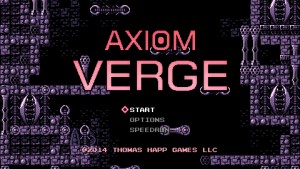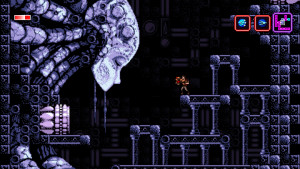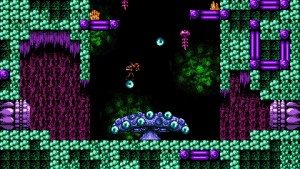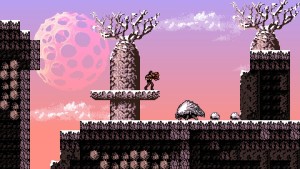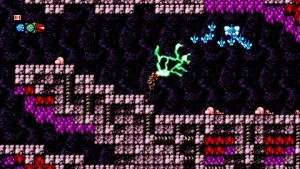On 6 August, 1986, Nintendo released Metroid for the Nintendo Entertainment System. At that moment, platform exploration games advanced in a way comparable to that which RPGs would experience following the release of Final Fantasy and Dragon Warrior. Years later, now-classic games like Super Metroid and Castlevania retained the core Metroid game mechanics in their own evolutions of the genre, and Axiom Verge follows in that noble tradition, both in adhering to the core gameplay mechanics available in Metroid, and in presenting new innovations which enhance the already-solid gameplay experience. The result is a blend of new and old which is at once refreshing and nostalgic. It seems prudent to add that, should an enterprising reader now begin downloading Axiom Verge from the PlayStation Network, the download will most likely be completed before this review is carefully read in full.
The plot of Axiom Verge is one respect in which significant advancement has been made since the release of Metroid. A cinematic sequence introduces the player both to the main character, Trace, and to the circumstances leading up to his exploration of a strange, alien world. There is more than a little of Another World and Blaster Master here, and the game thus aligns itself with these classic narratives from the beginning of gameplay, whilst arriving in the alien world itself connects the player to the opening moments of Metroid. Classic gamers will revel in this connexion with beloved games of yesteryear, whilst younger gamers will find in the opening moments of Axiom Verge a vehicle by which the player is swiftly involved in gameplay. There are no lengthy tutorials or long plot expostulation designed to ensure that even blockheads are following the story. Instead, Trace is given a gun and a world to explore: the rest is up to the player. Nor is the need for exploration limited to the world; each boss is a similar challenge–the weak points and strategies must be discovered and mastered until victory is obtained.
Although Trace is mostly on his own as he explores the world, he does receive occasional guidance from a gigantic, feminine cyborg named Elsenova. Apart from journal notes scattered and hidden throughout the world, it is Elsenova who fills in background details and gives Trace directions, albeit in broken, stilted English–a reference to the damaged nature of her components. Trace will, over the course of the game, aid Elsenova and her associates by repairing their damage and fighting off the gigantic bosses which infest their world. He will also learn more about Athetos, and the plague which ravaged the humans, leaving behind glitch-like fields which now impede his progress. Only as Trace acquires new equipment can he continue: jumping boots, grappling hooks, and a de-glitching gun are amongst the items that the careful explorer will find hidden–sometimes behind destructible or false walls. It is wise to explore thoroughly, lest valuable upgrades be overlooked.
Despite the presence of the story throughout, Axiom Verge never takes itself too seriously: in fact, its story delivery is most akin to a lighter version of that found in Metroid Prime, with background material delivered through notes and the occasional data console. As such, it never feels overwrought or overburdened: there is an absence of pretense which is all the more refreshing compared to the deadly earnest with which modern cheese-tastic stories are delivered by stilted voice actors. The small cast of characters quickly become familiar, and the world is fleshed out historically as the player explores geographically. Everything fits together snugly: it never feels as if the story is being forced upon the player, but neither does it fade into silent meaninglessness. Gamers will want to avoid the by-now habitual practise of pressing X to skip through what is usually meaningless blather, because in Axiom Verge, it is meaningful dialogue instead.
Lest it be thought that the music is forgettable, suffice to say it is not. Nominally an 8-bit soundtrack, the score to Axiom Verge has also benefitted from the technological developments of the modern era. Vocal samples and percussive drum effects flesh out a soundtrack which suits the world of the game admirably. And, although the soundtrack never quite reaches the lofty heights of Metroid or Castlevania‘s very best tracks, it also does not fall far beneath them. Audiophiles may find it difficult to recall the main themes of the game once separated from the software by distance and time, but when seated before the television set, immersed in the experience, it is not uncommon to find oneself humming along with electronic melodies that connect the gamers of 2015 directly to those of 1985. The aesthetic and narrative choices of Axiom Verge have been lovingly crafted and polished to pay such an homage, and in this regard it delivers again and again without fail.
With a vast array of weapons and power-ups, a huge world which is rewarding to explore, scores of hidden items, a soundtrack which fits perfectly, and an engaging storyline, it is hard to find anything about Axiom Verge which fails to live up to expectations. Too often, hype is built for a title to the point that its release cannot but fail to disappoint. This time, however, the promises have all come good. Axiom Verge‘s challenges are finely tuned, with Normal mode presenting a difficulty roughly on par with that of Super Metroid, and a Hard mode available at start. Frequent save points and the ‘return to save’ nature of death avoid the undoing of exploration whilst not removing all the costs of failure. A Speedrun mode is also available. The passwords of past platforming adventure games (JUSTIN BAILEY) have their place, too: they are now a part of the game mechanics, giving Trace new abilities and powers as they are entered and activated. In short, nothing of value has been overlooked; no rough edges remain unpolished.
When all is accounted, Axiom Verge is the kind of game that comes along once in a decade or more: it is both a faultless homage to the classic Metroid-style platforming-exploration games of the past, and also a glittering triumph all of its own which surpasses the achievements of earlier titles. It would have been easier for Tom Happ to have made a game that reached no farther than Metroid or Castlevania: Symphony of the Night, and such a game would have served well, would have pleased well, would have sold well, would have satisfied. But Happ has gone farther–he has innovated, not iterated–and the result is a timeless experience which delivers now as it will deliver again when it is inevitably replayed. Axiom Verge is therefore the best kind of retro game: one that deserves to be played not because it merely copies the classics, but rather because it is itself a classic, fit to stand alongside Metroid, Castlevania, and Blaster Master, with which it will remain a source of fun and inspiration in the years and decades to come.
